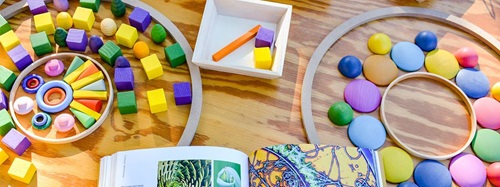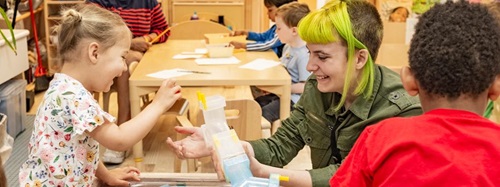A Special Place for Play in Special Education
| June 2014
As a speech and language pathologist in preschools for children with special needs, I sometimes joke that I have the best job in the world because I get paid to play with children. As educators of young children, we know it is not “just play” and that our jobs are a lot of work, in the same way that we know a child's play is also a child's work. With all that work and the mountains of paperwork we teachers face, is it possible that sometimes we might forget just how important play is? Do we really have time to get on the floor and play with cars? Can we take time to paint our own hands? Do we support play as part of our jobs? Can we explain what children are learning as they play? Perhaps we can also ask ourselves if we can play with purpose, or “intention,” because as Piaget (1962) argued, in order to think things through, children need to play things through.
Observation is Key
I’ve been mulling these questions over in my mind for several weeks now. During a recent work time, I glanced around our room to see just what was happening as the children played. Taylor, who has a craniofacial anomaly resulting in a vision problem, cognitive problems, and seizures, was in the greeting-time area pretending to “read” a big book to her imaginary class. Kario, who has Downs Syndrome, was at a magnetic board putting magnetic pictures, letters, and numbers on it. Isaiah, who has social-behavioral concerns, and Mateus, a typically developing peer, were playing with the train set. Seth, a student with autism, was grouping ABC blocks together, and Ben, who has Phelan McDermid Syndrome (a syndrome that affects cognitive and motor skills), was playing with the marble tower. If the principal, a parent, or another stakeholder of the class had walked in at that moment, it might have looked like “free play” to them. But I could see much more.
Taylor was expanding her language using a variety of four- to five-word sentences. Kario, who has limited vocabulary, was learning new words as she held up the magnetic picture of a guitar as if to ask “What is this?” The teacher explained to her what a guitar is and showed her the ukulele in our music box. Isaiah and Mateus were developing their social-emotional skills by conversing back and forth, sharing, trading, and negotiating train cars. Seth was grouping the blocks by letter and color – a cognitive classification skill. And Ben requested his favorite toy — one that uses marbles — by handing a picture of the marbles to a teacher, demonstrating his ability to represent objects.
Within just a few minutes of observing the children, I garnered valuable information about them in the areas of cognition and reasoning, social-emotional development, and math, language and literacy, communication, and fine-motor skills.
Play as an Intentional Intervention
Still, I know it takes courage and effort to promote play as an intentional intervention for children with special needs. We have pressures from many sources. We have legal mandates to meet, progress to document, and goals to meet. We face questions from anxious parents who want their children to learn as much as possible, and responsible policymakers who want us to justify that the extra expense of special education is worth the investment. But I believe we can find a way to do it. For example, we found a number of ways to support Ben (the builder of the marble tower) in his play.
It is likely that Ben will never use oral communication, and I wanted to give him another way to communicate. Eventually he will use a technological device (such as an iPad), but right now he does not have the fine-motor control to do so. A picture exchange system was the best place to start; but after two failed attempts at interesting him with pictures, I was discouraged. However, after talking things through with another teacher, we identified a small number of objects that Ben seemed most attracted to in his spontaneous play. Beginning with pictures of those objects, Ben began to use them because they facilitated his ability to carry out his own play ideas. Gradually, as he became more adept at using pictures to communicate his needs, we incorporated pictures of actions (including self-care routines) and feelings (from happiness to frustration). By beginning with play, we were able to open up a whole new world of communication for Ben.
As the discussion with my colleagues progressed, we really focused on a play approach and how we could support it by supplementing the pictures with spoken language. That is, we focused on play as the means to expand Ben’s communication skills. We set some goals for each adult in the classroom to have a set number (we chose five) of communication exchanges with Ben each day. I explained to the team that we wanted genuine communication exchanges, not just a barrage of questions. Now, even though Ben can’t talk, we each make comments to him and pause for him to respond in whatever way he can – using facial expressions and gestures, pointing at or sharing pictures, initiating actions, and so on. We comment on what we see, what we are doing, and what he is doing. We converse with him, play with him, interact with him. He is responding and becoming more engaged with people and materials each day. And we are seeing a documentable difference in his participation in each part of the routine and in his overall engagement. Most gratifying, Ben appears to be enjoying school more, and we take increasing delight in interacting – playing – with him. It is a mutual learning experience.
What about goals?
Paperwork, standardized tests, goals, audits, team meetings, data collection, and so on, are realities for us. Most preschools for children with special needs have a curriculum to follow, and the children also have IEP goals to meet. It is easy to see why we feel like the only way we can accomplish it all is to pull the children aside and work on specific skills. Therefore, it is even more important for us to remember how all preschool children, regardless of ability, learn. They learn intrinsically by making choices based on what interests them, manipulating materials and ideas at their own pace. If we want children to learn, we are wise to respect their plans and support their choices. This can be done when we consider play as an intentional intervention. That is, we deliberately create opportunities for play because play provides the occasion to scaffold (support and gently extend) learning. We as teachers advocate for play, support play, and plan for play to happen throughout the day.
For example, many students in our class have fine-motor goals so we have toys, materials, and activities that facilitate fine-motor activities. One of the children in our classroom, Grey, will be going to a regular kindergarten class next year. He uses a fist grip with crayons, pencils, and markers, and he has a fine-motor goal addressing his writing skills (to help him progress toward using a tripod – thumb and two-finger – grasp). We have found the occupational therapist to be a great source of ideas for what to work on next with Grey and for ideas for activities, classroom materials, and special-needs adaptations. We have started doing small-group activities with writing tools and other activities to strengthen children's hands. We also make sure the tools and activities are available during work time. Even so, Grey is not very interested in writing activities. He is, however, very interested in building towers with blocks, and he does so almost daily. So, we added writing materials to the block area, along with maps, diagrams, markers, and whiteboards. We have boxes covered in paper that Grey can draw on to make into any kind of block structure (such as a McDonalds restaurant or his house). He also makes signs and roads. I take pictures of some of his projects and print them, and then he “writes” about the picture. It will take time for his writing-related fine-motor skills to develop — he doesn’t choose these activities every day, but with our support and trust in his play, his grip will continue to develop. We observe him, watching for signs of progress, and we record what we see. We also play alongside him to provide encouragement, support his independent efforts, step in when we sense he is getting frustrated, comment on what he is doing, and acknowledge his pride in his achievements.
To begin using children's play as an intervention was a change of strategy for us as teachers. We went through some growing pains as we transitioned from more traditional “pullout” modes (where therapists take a student or small group of students to an office to work on IEP goals) to an approach of working on goals within the classroom setting throughout the daily routine. However, keeping in mind that play as an intervention is best practice for all children, we are committed to using it.
References
Fröebel, F. (1826). On the Education of Man (Die Menschenerziehung), Keilhau/Leipzig: Wienbrach.
HighScope Educational Research Foundation & Red-e Set Grow. (2013). COR Advantage [Computerized assessment system]. Online at http://coradvantage.org
Piaget, J. (1962). Play, Dreams and Imitation in Childhood. New York: Norton.
Adapted from A Special Place for Play in Special Education, HighScope Extensions newsletter, Vol. 28, No. 2, Ypsilanti, MI: HighScope Press. Retrieved from www.highscope.org. ©2014, HighScope Educational Research Foundation. Used with permission.






